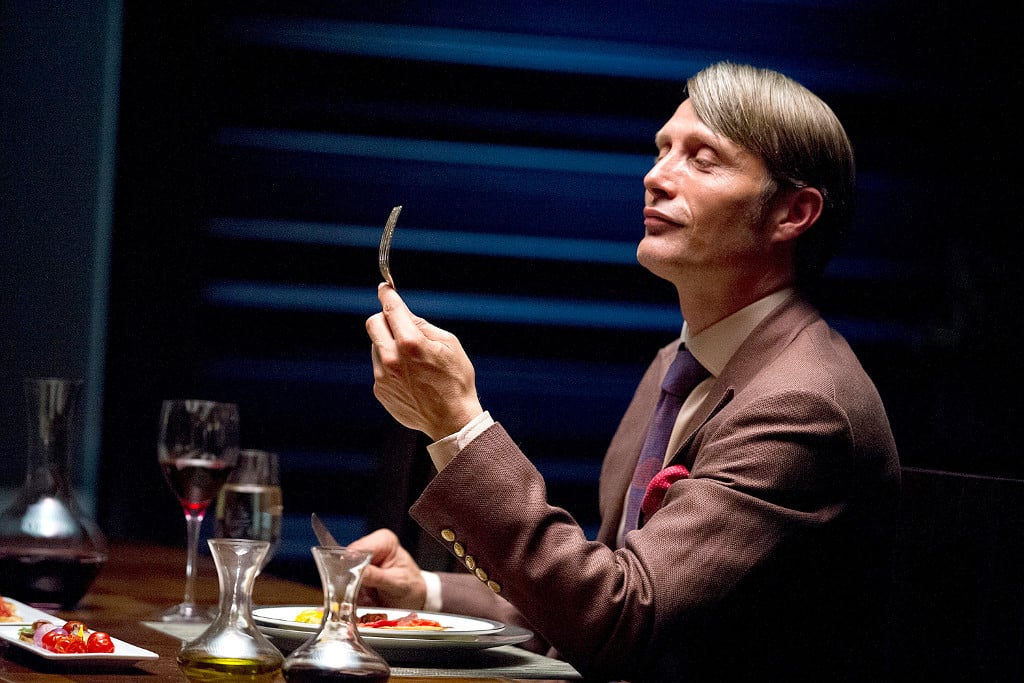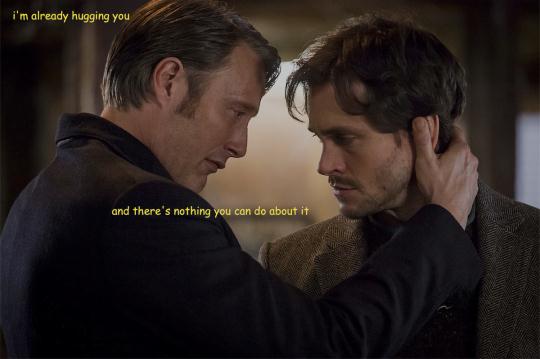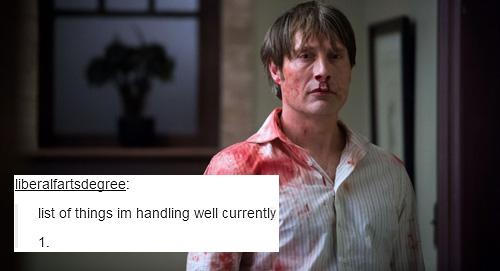‘Hannibal’ Is One Of The Best Shows On TV Because It Brings Us Closer To The Idea Of Death
In a culture that tries so hard to ignore death, 'Hannibal' forces us to confront our own mortality.

[Update June 23]: NBC announced overnight that season three of Hannibal will be the last. “NBC has allowed us to craft a television series that no other broadcast network would have dared, and kept us on the air for three seasons despite Cancelation Bear Chow ratings and images that would have shredded the eyeballs of lesser Standards & Practices enforcers,” said showrunner Bryan Fuller. “Hannibal is finishing his last course at NBC’s table this summer, but a hungry cannibal can always dine again.” There is already a Change.org petition to save the series circulating, which at time of publish had amassed over 10,800 signatures.
–
Love and death are the great hinges on which all human sympathies turn –
Hannibal Lecter (cribbing from B. R. Hayden)
–
NBC’s Hannibal (returning this month for its third season) does for history’s most terrifying film villain what the Renaissance did for Jesus: it takes our faith and imagining of an otherworldly being and makes him human. The deep irony is that making Hannibal Lecter into more of a man than a monster, rather than defanging the beast, serves only to make his bite all the more frightening.
For all of Hannibal’’s skilled deployment of twisted horror tropes and beautiful, intricate detailing, its true power lies in the show’s deeply emotive and psychologically powerful exploration of love, death and grief. While our first sight of Hannibal Lecter is a sparsely lit face, looming in the shadows doing an uncanny impression of the actual mask of death (not to mention chewing on God knows who), his true introduction comes in his perfect and perfectly doomed meet-cute with FBI profiler Will Graham. Two isolated men, one struggling with a surplus of empathy, the other a deficit, Will and Hannibal develop a unique bond over their knowledge and experiences of death and loss, and over the course of the two seasons, it becomes clear that their personalities complement and bleed into one another as beautifully as two sides of a barely-dried Rorschach test.

Hannibal Lecter is a post-modern Renaissance man: he plays musical instruments, he wears bespoke tailored suits, enjoys sketching and reading, flirting and intellectual conversation and is a mean cook. He has a passion for life and an enviable certainty about his person more inspiring than all the inspirational cross-stitching on Etsy combined. When revealed in Season Two as the serial killer the FBI have been looking for all along, he claims his violence is driven by a twisted urge to civilise: that “wherever feasible, one should always try to eat the rude”. For a man of such impressive intellect, you have to wonder how he can believe that killing and eating people isn’t at the very least pretty darn rude in and of itself. But as with anyone’s secret self-justifying motives, the idea is less a strict guideline for behaviour and more a signpost for where his private thinking veers off from more conventional thought.
While lesser shows might set up his sadistic nature against his cultured artifice as opposing forces at odds within him, Hannibal shows them as coexistent parts of the same person. He wears his passion for culture and urbanity in the same way a teenager wears a One Direction t-shirt: as a symbol of his membership to his chosen strata of society. But the subconscious drive within him shapes even his ‘person suit’, leaving clues all around for those who care to look: his office waiting room wall hung with a painting depicting cannibalism, Leda and the Swan hung obtrusively in his dining room.

But there are clues in more than just his selection of décor. Hannibal isolates the people around him in order to better influence and gain power over them. He keeps and uses secrets, the stock in trade of any good manipulator, using them with, about and against his colleagues, patients and friends. He finds more uses for gaslighting than London in a Sherlock Holmes novel and pits his murderous psychiatric patients against one another like a Roman Emperor programming his own personal coliseum. When Hannibal’s psychiatrist, Bedelia Du Maurier, visits Will Graham during his incarceration (framed by Hannibal for Hannibal’s own crimes, no less), she tells him, “It may be small comfort, but I am convinced Hannibal has done what he believes is best for you.” “That would be no comfort at all,” Will responds, and hits exactly on why this makes Hannibal so frightening: this is not some kind of moustache twirling, imaginary evil – the pain and suffering Will is experiencing is genuinely what Hannibal believes love is.
With the seamless emotional logic of any truly terrifying nightmare, Hannibal supplements Hannibal’s twisted psychology by invoking a world steeped in grief and trauma. By opening the series with Will shooting dead serial killer Garret Jacob Hobbs in order the save his daughter Abigail, the atmosphere is always thick with either the possibility or aftermath of violence. There’s a physicality to watching Hannibal, evocative of the deep PTSD swing between uncertain, hard-to-comprehend fugue state and the plunging, jolting panic of sudden adrenaline. And between these moments of deep fear, there’s always something of the post adrenaline ache in your veins and nausea in your throat, as though even when the terror is over, there’s still so much to process and pass through. Fear changes your brain at a molecular level and the experience of living in Hannibal’s world changes their personalities at a similarly fundamental level.

Hannibal‘s humanisation of evil captures a truth that our pretense at culture and civilisation seeks desperately to keep hidden. While evoking much of the imagery and ideas of Judeo-Christian thought, the show goes well beyond the broadly understood concepts of good and evil found in conventional texts to explore the ideas in a new way. The murder tableaux somehow manage to transform the cruel and irrevocable finality of death into mediations on finding meaning in loss. Even more powerfully, they and the characters tell the story of how grief and death are just as much the cornerstones of our world as love and birth.
Human guts are used to make cello strings for a young boy to learn to play. A collection of bodies is stitched into a mural reflecting the beauty of colour and God’s (imagined) imagination. A woman with a songbird (literally) in her heart is entombed in a horse to grant her rebirth. These grim and fantastical creations make Davids Lynch and Cronenberg seem like a pair of uptight, frigid squares, but even in their cryptic uniqueness they evoke connections to the real world: how Egyptians would bury servants with their Kings so they would be served well in the afterlife, how human bones were once used to make flutes and spears and cups and jewelry. And you don’t have to think back very far to consider how much blood has been spilled and lives lost over ideas about god and race. Blood and death not only touch every facet of our lives, they are soaked in the very foundations upon which we build our world.

The dream/nightmare state that Hannibal exists in is a fantastically frightening counterpart to most shows about investigating murders. While simpler shows such as Law and Order always show logic and rationality triumphing over emotionality, even Will Graham, ostensibly the FBI’s best hope of catching Hannibal Lecter, believes “faith in any sort of legal justice has never been any more comforting than a night light.” Beyond any idea of imprisoning killers or justice or even peace, it is the fear of being consumed by these experiences and emotions which forms the true horror of Hannibal. As Hannibal tells Will: “Who you were yesterday is laid waste to give rise to who you are today.”
Late in the second season, Will tells Hannibal he still dreams about Abigail Hobbs, a single tear slipping down his cheek as even in his betrayal and hurt by Hannibal, he is still the only person Will can bring himself to tell. Dreaming of a lost loved one, as anyone who’s ever experienced it can attest, is a powerful reminder of how deeply those we love become imprinted within us. In our unconscious minds, those we love and lose continue to live as though nothing has changed. But night light or no, the horror is in the waking, and the realisation that however how real your dream feels, when someone dies, they are gone forever. And that includes the people we used to be.

In the same way Hannibal’s cannibalism works as a metaphor for the way relationships and experiences consume, destroy and absorb parts of people into one another, Hannibal’s underlying story is one of constant creation and destruction and resurrection and transformation. It features subverted and reimagined horror tropes in fantastic and beautiful ways, but the fundamental terror it explores transcends the fear of a serial killer jumping at a pantry door or chasing you up the stairs.
Hannibal is humanised by his love for Will Graham because it shows him experiencing the deepest of fears: that what he believed immutable and permanent in himself can be changed and consumed by his bond with another. The deep and fundamental horror of Hannibal is the twining pull and repulsion of death itself. How powerfully alive the characters feel in their closeness to destruction. How alive we feel in the very moments that parts of us are being lost. How close the feeling of love is to agony and how, even in our closest moments of intimacy, we can be losing ourselves and one another at the very same time.
–
Hannibal airs at 8:30pm Thursdays on Showcase (Foxtel) from July 2.
–
Courteney Hocking is a Melbourne writer and reformed comedian who has written for Good News Week, The Guardian, The Age & Crikey. You can find her general smart-arsery & Hannibal memes @courteneyh.